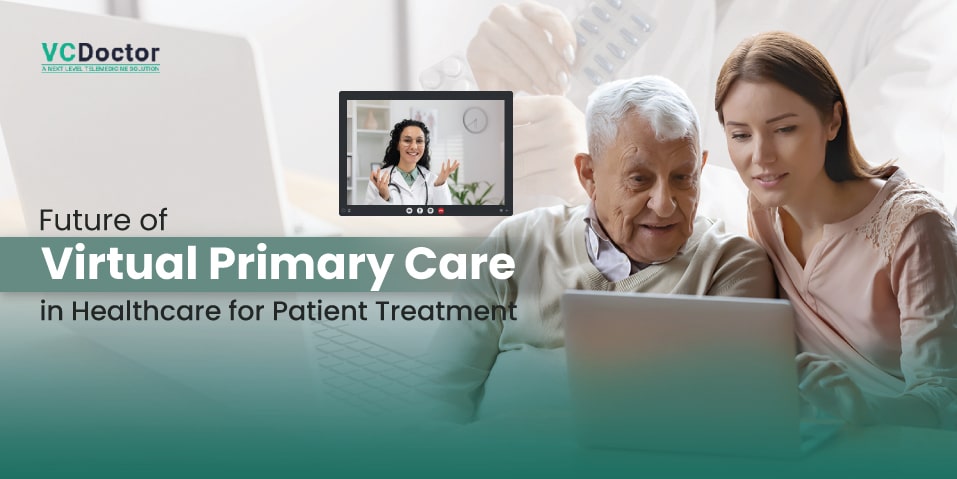Future of Virtual Primary Care in Healthcare for Patient Treatment
Virtual primary care in healthcare has a great scope in the future. It is because digitalization has taken over the world. People nowadays have access to almost everything in their hands- a smartphone and internet connectivity, that’s it. Other than this, a public health crisis like COVID-19 forced people to stay home to avoid coronavirus exposure. Due to this, telehealth primary care/primary care telemedicine software came into existence to offer needed diagnoses and treatment for patient’s acute illnesses. And keep on advancing during these years.
Now the tech-savvy generation prefers virtual healthcare through telehealth vs telemedicine not because it eliminates physical contact but also greatly saves time and money. In other age groups, people who have utilized and experienced the benefits of virtual primary care are turning 100% towards virtual healthcare. Therefore, it is certain that virtual primary care will grow in the future.
Table of Contents
- What is Virtual Primary Care?
- How Does Virtual Primary Care Work?
- Why Use Virtual Primary Care?
- What is the Future of Virtual Health?
- Advantages of Virtual Primary Care
- Why Does VCDoctor opt to be best Virtaul Helath App?
- Conclusion:
What is Virtual Primary Care?
Virtual Primary Care is the delivery of healthcare services by a doctor or healthcare provider to a patient via video or phone visits. It comprises 3 major components.
- 24/7 urgent care
- Chronic care
- Preventive screenings
24/7 urgent care / virtual urgent care deals with patients’ unexpected visits for acute illnesses such as rashes, coughs, nausea, vomiting, diarrhea, and bladder infections. During the virtual visit, a doctor can prescribe medication to treat the patient’s illness and send it to the patient’s pharmacy of choice electronically.
Virtual chronic care easily manages chronic conditions like diabetes, high cholesterol, and hypertension. In most chronic cases, the patient requires extensive counseling on nutrition, exercise, and alarming signs of complications. Thanks to virtual chronic care, patients can leverage easier, longer, and more frequent doctor visits to better manage their counseling needs. Also, patients experience the frequent need for lab tests in chronic care, such as LDL levels for high cholesterol and haemoglobin A1c for diabetes. However, these blood tests need to be performed in person, but a virtual primary care doctor can electronically send an order to a local, cost-effective lab facility near you to collect the samples.
Virtual preventive screenings with the patients can be performed or coordinated virtually. This can better be understood as questionnaire-based screenings with the patient during virtual visits. For example, screenings for depression and alcohol abuse. Or a virtual primary care doctor refers patients to a gastroenterologist for colonoscopy screening and women to a local imaging center for mammograms screening.
How Does Virtual Primary Care Work?
Virtual primary care, which is a form of primary care, utilizes technology to provide patients convenient face time with their primary care providers. Patients can leverage virtual healthcare wherever and whenever they want. The only thing they need is a smartphone, tablet, or laptop with good internet connectivity. They don’t need to leave their office early and beat the traffic to the doctor’s office. Or even wasting their time sitting in the waiting area.
However, the method remains consistent across the board, but not every virtual care provider needs to use the same approach. Therefore, while choosing your virtual patient care provider, always look for the practice that better resonates with your health goals.
A virtual care provider that offers complete support for your health and well-being is always the best option. You wouldn’t get access to only a primary care provider, but also to its whole care team. The care team deliberately listens to every person to know their health concerns and delivers a personalized experience to every unique person.
Other than this, the patients can easily connect with the entire care team through an app. They can have video chat with their clinician anywhere, anytime. Message for health guide with a quick question, send a photo, or request for a prescription refill in no time. This is the most convenient way to get the care you deserve through virtual primary care.
Why Use Virtual Primary Care?
Primary care has already showcased its significance in improving patients’ health and lowering healthcare costs with early detection and treatment of diseases like cardiovascular disease and cancer. However, in the last two years, only 33% percent of people mark their presence with primary care physicians. This showcases a higher reduction in in-person visits post-COVID.
The reason being people don’t want to visit a doctor’s office. To make a doctor’s office visit, they have to take work off or arrange for childcare, travel and wait there in a waiting room. This induces a lot of patient time and money. According to a study, many doctor visits cost over $100 on a high-deductible health insurance plan.
On the other hand, virtual primary care is quite easier to access and less expensive comparatively. The patients can conduct doctor visits at home, at work, or even in their parked car. It can benefit employees with 0 out-of-the-pocket costs like an onsite clinic, near-site clinic, or direct primary care. Virtual primary care simply reduces barriers and increases access to patient care.
What is the Future of Virtual Health?
The future of healthcare is rapidly evolving into an environment filled with virtual health options. The days of remote locations preventing patients from receiving expert consultations are long gone; in the future, ordinary examinations will be carried out from the convenience of an office chair or a patient’s home. This paradigm shift has the potential to completely transform patient participation and healthcare delivery. It is being driven by developments in white label telemedicine technology. Healthcare providers can remotely monitor chronic illnesses and take preemptive action and provide real-time data.
Artificial intelligence will become a powerful tool with the capacity to evaluate massive information, customize treatment plans, predict future health issues, and optimize resource allocation. Wearable technology and remote monitoring tools will enable patients to actively participate in their health journeys. Eventually, virtual health will strive to go beyond basic convenience and democratize access to high-quality healthcare in order to provide a more connected, data-driven, and preventive healthcare environment.
Advantages of Virtual Primary Care
Virtual primary care leverages healthcare with a host of benefits which are as follows.
Direct Access to Primary Care Doctor Instead of “a” Doctor:
This is one of the major advantages of using virtual primary care. As with DEA telemedicine, the patient must first scan a database of doctors to choose the best-suited physician for treatment. Later on, the process begins with a series of questions to provide treatment recommendations or prescriptions. The information collected during the session is then sent to the patient’s named primary care doctor. But when the patient visits telemedicine next time, they have to go through the get-to-know-you process all over again.
On the contrary, virtual primary care allows a patient to connect with the same primary care doctor every time-their personal virtual primary care doctor. One who knows and has complete access to that patient’s medical history. The same doctor knows and understands his patient’s unique health concerns.
VPC Provider Better Manages Patient’s Chronic Disease:
Telemedicine for doctors provide treatment advice and write descriptions for a narrow list of acute conditions and symptoms that don’t meaningfully affect the dollar amount an employer’s health plan spends. It is because they don’t provide ongoing treatment for the patients who have already been diagnosed with chronic diseases treatment. On the contrary, a VPC provider who has access to your medical history, knows your symptoms, your medications, and how well your condition is controlled currently becomes your trusted partner in managing your chronic care.
Specialty Care, Labs, Diagnostics, Health Coaching, and More
Unlike general telemedicine, few virtual primary care providers grant specialty care, labs, diagnostics, health coaching, and more to their patients at drastically reduced fees. These VPC providers keep their patients’ data in electronic health records systems to see a complete picture of their health and wellness.
Why Does VCDoctor opt to be best Virtaul Helath App?
VCDoctor distinguishes itself in the competitive telemedicine startups by prioritizing a patient-centered, feature-rich experience. The platform goes beyond simply connecting patients with doctors. It offers seamless virtual consultations with qualified healthcare providers, streamlines medication delivery, and empowers users with educational resources to manage their health proactively. VCDoctor aspires to be a comprehensive solution, encompassing the full spectrum of virtual health needs from consultations and prescriptions to ongoing health education all within a user-friendly and secure platform.
Want to invest in Primary Virtual Care? VCDoctor your true telemedicine partner
Conclusion:
Going through the blog, you must have known almost everything about virtual primary care. Also, you get an idea that virtual healthcare is here to stay and will grow significantly in the coming future. Therefore, the healthcare businesses or organizations which did not make their way towards virtual health should think again and mark their presence as primary care providers. To do so, they can build custom telemedicine solutions or can integrate white-label telehealth solutions from the industry’s best telemedicine solution providers.
VCDoctor is one such prominent name in the field of telemedicine app development. Healthcare service providers can rely on VCDoctor as its product is an all-in-one, HIPAA compliant, safe, and secure, white-label solution. They can personalize solutions as per their unique business requirements and make the most out of them. For more information about VCDoctor telemedicine services, you can consult with our healthcare experts or visit our official website.
FAQs
What is virtual primary care and how does it work?
Virtual primary care uses smart technology to provide remote healthcare services from. Now, doctors and patients can communicate over the phone or through secure video conferencing. It helps them get rid of the necessity for in-person visit by regular checks, medication refills, and chronic illness management via video calls .
How will virtual primary care impact patient treatment?
There are various benefits to virtual primary care.
- Improved access to care: This increases healthcare accessibility for people living in rural locations or with limited mobility.
- Enhanced convenience: Reduces travel inconveniences and saves patients time compared to typical visits.
- Improved patient engagement: Because access is easier, people may be more inclined to seek preventive treatment and better manage chronic illnesses.
- Potential cost savings: By cutting down on pointless in-person visits, this may result in cheaper healthcare expenses.
- Streamlined communication: Makes it simpler for patients and providers to communicate via online portals or messaging services.
Are there any limitations to virtual primary care?
Although advantageous, virtual primary care has drawbacks:
- Restricted physical exams: Some medical issues may necessitate a physical examination that cannot be done online.
- Dependency on technology: For online consultations, patients must have dependable access to technology and internet connectivity.
- Possibility of impersonal communication In a virtual situation, developing a strong relationship between the patient and the doctor could be more difficult.
- Data security and privacy issues: Strong cybersecurity safeguards are essential for patient data privacy protection.
Who is a good candidate for virtual primary care?
Those who need routine treatment, are managing chronic diseases, or have transportation issues can benefit from virtual primary care. It might not be the best option, though, for people who are uneasy with technology or for complicated medical conditions that call for physical tests.
How will virtual primary care evolve in the future?
Virtual primary care has a bright future. Patients will receive more thorough data when wearables and remote monitoring devices are integrated. Furthermore, more interactive and immersive virtual consultations will be made possible by improvements in vet telemedicine technologies. As virtual care gains traction, the emphasis will move to developing precise policies and procedures for the best possible patient care.




